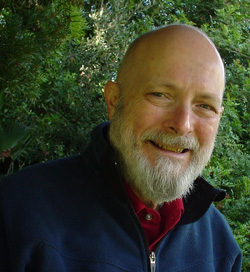Vernor Vinge is a retired San Diego State University Professor of Mathematics, computer scientist, and science fiction author. He is best known for his Hugo Award-winning novels and novellas A Fire Upon the Deep (1992), A Deepness in the Sky (1999), Rainbows End (2006), Fast Times at Fairmont High (2002) and The Cookie Monster (2004), as well as for his 1984 novel The Peace War and his 1993 essay “The Coming Technological Singularity,” in which he argues that the creation of superhuman artificial intelligence will mark the point at which “the human era will be ended,” such that no current models of reality are sufficient to predict beyond it.
Children of the Sky, the long-awaited sequel to A Fire Upon the Deep comes out from Tor Books on October 11th. I recently sat down with Vinge for an interview where we discussed Children, the Singularity, and more.
JOHN OTTINGER: How do you pronounce your last name? I heard somewhere that your last name rhymes with “Benji,” not “hinge,” but I don’t know that for a fact. I’ve always said it as V(h)inge. Am I off base?
VERNOR VINGE: I pronounce it as rhyming with the word “stingy.”
OTTINGER: Do you still think the Singularity will happen within 20-30 years? Why or why not?
VINGE: Barring catastrophes such as world nuclear war, I’d be surprised if the Technological Singularity hasn’t happened by 2030. The enabling technologies of computation and communication seem to be going like gangbusters. By the way, I think my 1993 essay, still does a good job of addressing many Singularity issues.
OTTINGER: Is the Singularity more likely to be a positive or a negative thing for humans, and is there any way we can push it one way or the other?
VINGE: Given what makes the Singularity, namely the advent of superhuman intelligence, the consequences are essentially unknowable. They could be positive, but so extremely positive as to raise basic questions about the meaning of things humans have always yearned for (eg, immortality).
Yes, I think we can affect the outcome one way or the other. The runup to the event is not unknowable. There are a number of paths to the Singularity. Paths that lead to a very quick transition (a hard take-off) are probably dangerous. If the Singularity grew out of a military arms race, that would likely be bad news!
I talk a little more about hard and soft take-offs in “Signs of the Singularity.”
OTTINGER: In The Children of the Sky, is the focus going to be on the Tines planet when the fleet arrives?
VINGE: The novel takes place on Tines World, from 2 to 10 years after the end of A Fire Upon the Deep. Almost all of the surviving children have been revived from coldsleep. The fleet that was pursuing Ravna has not arrived. (When it might arrive is an existential uncertainty for everybody.)
OTTINGER: Is the Blight actually destroyed / crippled, or just temporarily suppressed?
VINGE: No one knows the fate of the Blight’s empire in the High Beyond and the Low Transcend. Ravna Bergsndot believes that an encysted form of the Blight is aboard the fleet and that the fleet is still coming toward Tines World.
OTTINGER: You write what is often termed “hard” science fiction—your extrapolations are based on real science. Is it important for fiction writers to ground their stories in real science?
VINGE: No. Hard science fiction is a cool subgenre within science fiction, but the edges of hard SF are blurred and debatable. For instance, I think some people figure that faster-than-light travel would disqualify a story from being hard SF (but not me).
OTTINGER: Many of my friends often complain that “hard” science fiction is like reading a scientific treatise. It’s much too dense to follow and requires a science or technology degree to enjoy. What response do you have to such claims?
VINGE: Fortunately, there’s a very wide range of readers. I know readers who like stories that are more “treatise-like” than what I can enjoy. My goal is to write something that will be enjoyed by readers who regard all the techie parts as opaque magic. At the same time, for readers who want to think about the science, I want the same story to be fun for that. That’s a tricky goal, and there’s a danger that the effort may fail on both counts!
OTTINGER: The Children of the Sky, your sequel to A Fire Upon the Deep comes out in October. It’s been almost twenty years since the first book. What writing challenges were posed by the time distance between stories?
VINGE: The 19-year gap between publication dates was a potentially embarrassing problem. I was fortunate: The “internet” in A Fire Upon the Deep was interstellar and faster-than-light, so the fact that the bit-rates were low by 2011 standards can scarcely be held against it.
Also, about half the story took place on a low-tech world, which reduced the problem of inconsistencies in writing The Children of the Sky.
OTTINGER: What other projects are you working on?
VINGE: I have some small publicity assignments related to the upcoming release of The Children of the Sky. At the same time, I’m trying to decide if the next novel should be near future (like my 2006 novel Rainbows End) or far future (like The Children of the Sky). And I’m desperately trying to figure out how to write something shorter than these last few novels, so I can get it done faster!
OTTINGER: Thank you for your time!
Special thanks to my friend J. for helping me formulate these questions.
John Ottinger welcomes the advent of the Singularity, but until that time, he does his part to bring it about by editing Grasping for the Wind.com.










